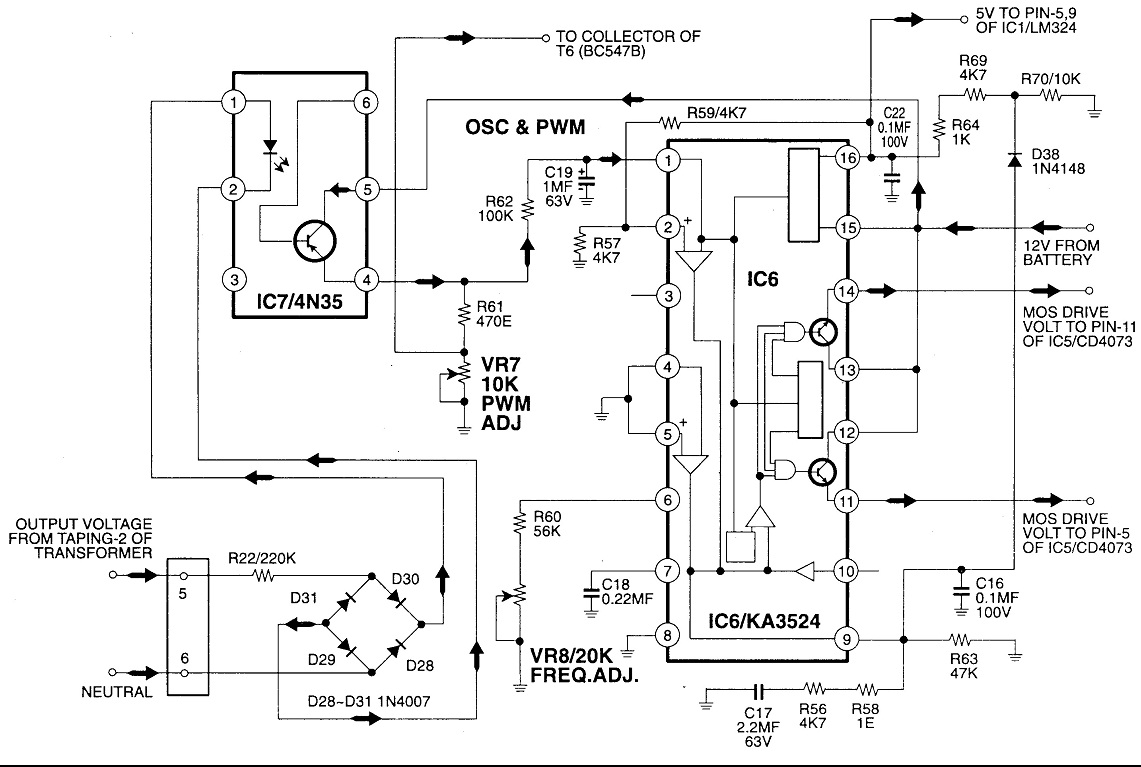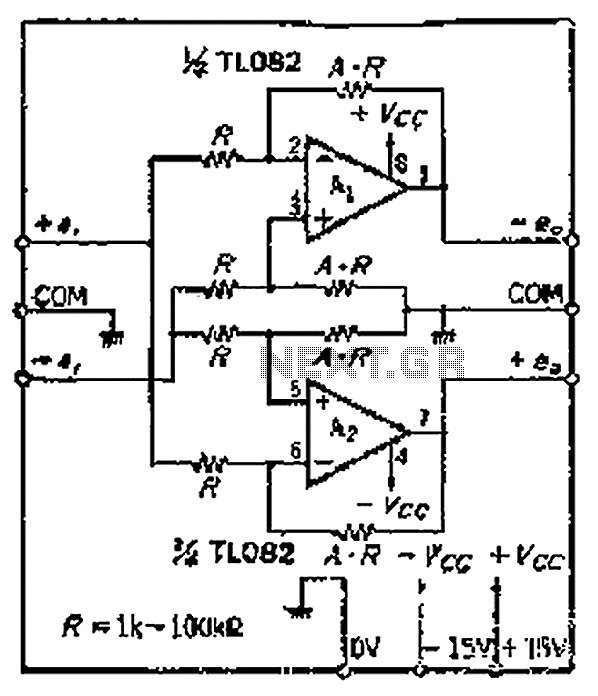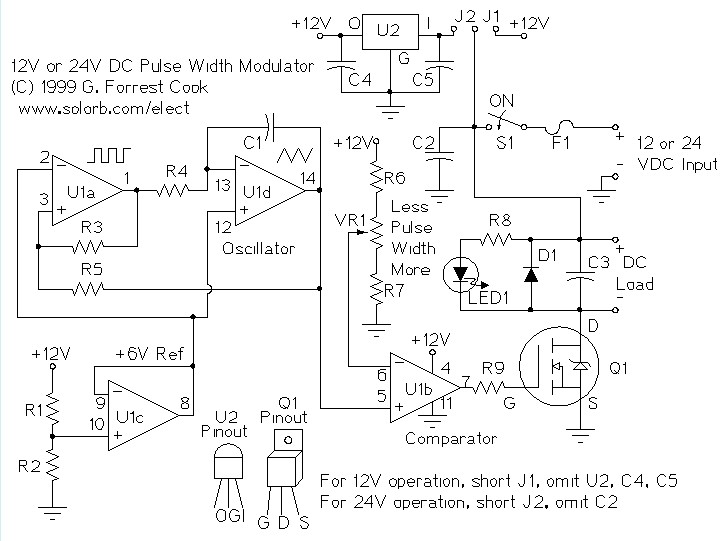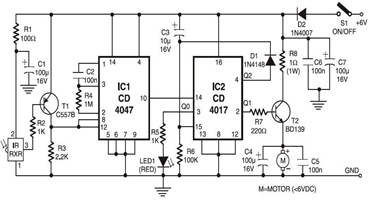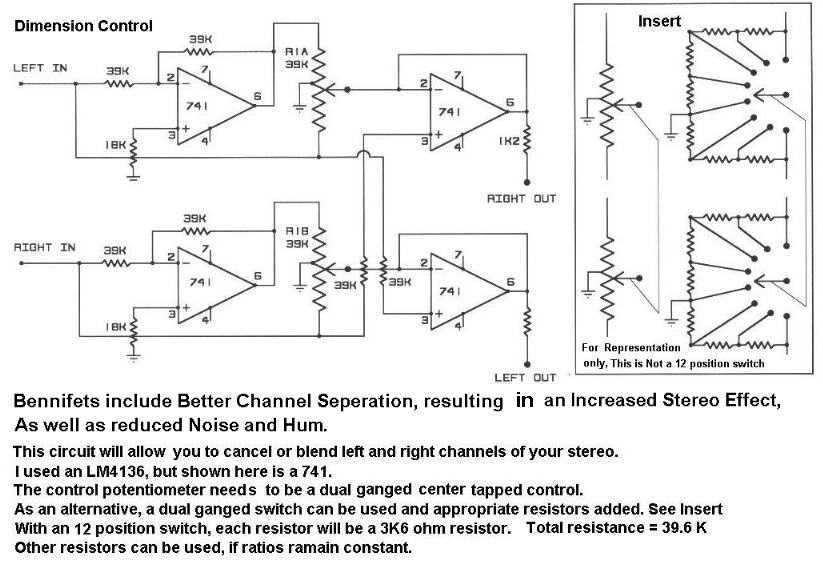
picaxe 18X repeater controller
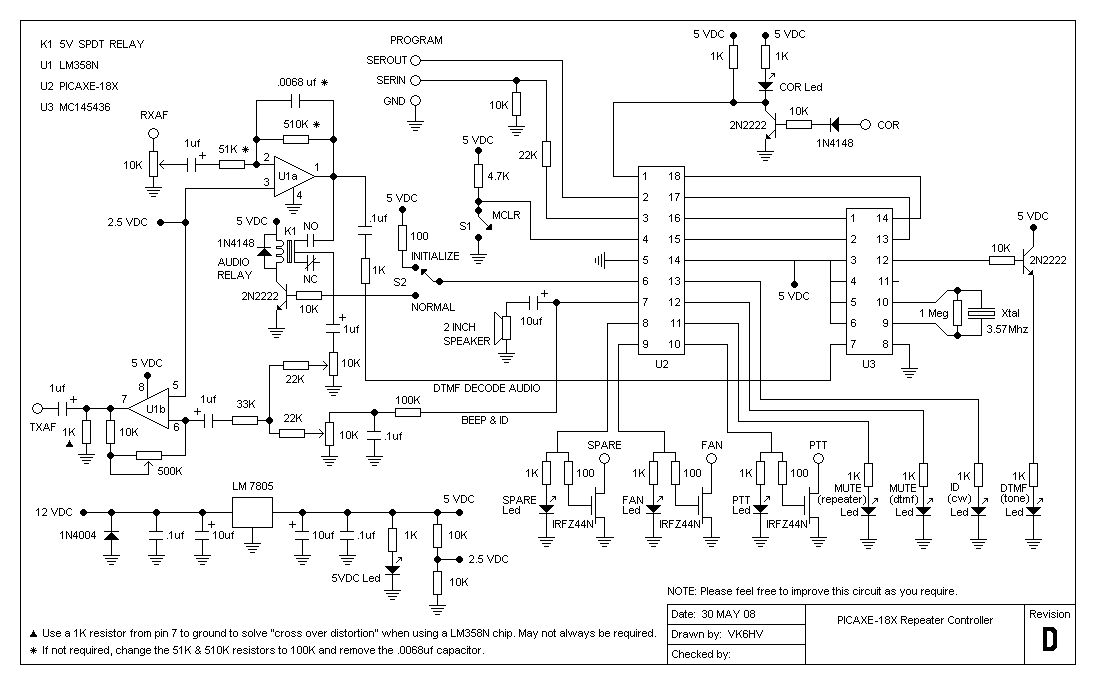
The project involves testing the capabilities of a PICAXE-18X chip operating at 4 MHz for a specific application. It includes designing the circuit, creating printed circuit board (PCB) artwork, etching the PCB, programming the PICAXE in BASIC, and connecting the circuit board to surplus VHF radios as a repeater. The author is one of four amateur radio operators in a 300-mile radius utilizing an NHRC-4 controlled 2-meter repeater in North West Australia and acknowledges that the circuit may not be used frequently. Contributions and improvements to the project are encouraged. The audio section of the project is based on a design found on another amateur radio operator's website, credited to K5LXP, and may have been featured in a "QST" magazine article about ten years ago. The project utilizes an MC145436 DTMF chip for remote control and programming changes, featuring common functionalities found in other repeater controllers, such as adjustable time-out timers, ID timers, Morse Code identifiers, and programmable Roger beeps. All settings can be adjusted using DTMF tones after downloading the BASIC program to the PICAXE chip. The controller can provide audio ID to a small speaker, which is useful during programming. The design includes three power MOSFETs, nine status LEDs for various indicators, and was created using Microsoft Paint without specialized PCB layout software, although the author has since acquired such software. There are two versions of the project: a basic PICAXE-08M version and the advanced PICAXE-18X version. The PCB artwork photos were initially in BMP format but were converted to JPG to save space. A note emphasizes the importance of printing the artwork correctly, recommending importing BMP files into a Word document for better quality prints.
The PICAXE-18X repeater controller circuit is designed to facilitate remote operation and control of a VHF repeater system. At its core, the circuit utilizes a PICAXE-18X microcontroller, which operates at a frequency of 4 MHz. This microcontroller is programmed in BASIC, allowing for straightforward coding and adjustments. The circuit is equipped with an MC145436 DTMF decoder chip, which interprets dual-tone multi-frequency signals, enabling remote control functionality for various repeater settings.
The controller features several adjustable parameters, including a time-out timer and ID timer, which can be set to specific durations as required for the repeater's operation. The inclusion of a Morse code identifier allows for automated identification of the station, with the capability to store up to 11 unique identifiers. The design also incorporates a user-friendly interface for programming, utilizing DTMF tones to modify settings without the need for direct access to the microcontroller.
Power management within the circuit is handled by three power MOSFETs, which serve as switches for different components of the repeater system. Two of these MOSFETs are actively used, while one is reserved for future expansion or additional functionality. The circuit includes nine status LEDs, providing real-time feedback on various operational states such as power supply status, carrier-operated relay (COR) activity, and DTMF tone reception. This visual feedback is crucial for troubleshooting and ensuring proper operation of the repeater.
The PCB layout was created using Microsoft Paint, and while this method proved labor-intensive, it demonstrates the feasibility of DIY PCB design without specialized software. The project also highlights the importance of proper printing techniques for transferring the PCB design onto the etching medium, recommending the use of laser printers and specific transfer papers for optimal results.
Overall, this project serves as a practical application of microcontroller technology in amateur radio, showcasing the integration of digital control with traditional radio operations. The design encourages further enhancements and adaptations, inviting collaboration and innovation within the amateur radio community.Decided to quench my curiosity and see if a PICAXE-18X chip running at 4Mhz. was capable of this application. I also wanted to have a go at a project from the ground up. Designing the circuit, drawing up the printed circuit board artwork, etching the circuit board, programming the PICAXE in BASIC and hooking up the circuit board to a couple of surplus VHF radios as a repeater. Being that I am only one of four amateur radio operators in a 300 mile radius that uses our NHRC-4 controlled 2 meter repeater here in the outback in North West Australia, it`s possible that I will never use this circuit. So I encourage anyone to make improvements to any part of this project. The audio section of this project is not my design but was found on another Amateur Radio Operators web site elsewhere on the net.
Thanks K5LXP. Also, I think it was a featured article in the magazine "QST" about 10 years ago. So it seems to be the standard OpAmp audio circuit for a simple PIC approach to controlling a Amateur radio repeater. This project uses a MC145436 DTMF chip for remote control and remote program changes. This basic controller features standard features in many others repeater controllers. Adjustable Time Out Timer, adjustable ID Timer, Morse Code Id`er with 11 available spaces for the call, i.
e. DE_XX#XXX/R, adjustable Hang Timer delay, 3 programmable Roger Beeps, 3 digit password, all programmed in decimal. not HEX! All programmable via DTMF tones once the "BASIC" program has been downloaded into the PICAXE chip with the program and defaults settings.
It also ID`s to a small speaker if required. I found the Speaker Output handy while programming. There are 3 power MOSFETs as switches, 2 used and 1 spare. There are 9 status LED`s for such things as 5 volts OK, COR active, Morse ID, DTMF Tones OK, Mute DTMF Tones, Repeater Muted, PTT Active, Fan ON and a spare status LED for the spare MOSFET switch. Oh, this was very painful. It was all done with the MicroSoft "Paint" program. No special PCB layout software was used. (but I`ve purchased some software now!) It took hours and hours. and more hours to draw up. There are actually two versions. A bare bones PICAXE-08M version and this PICAXE-18X version. The photos of the artwork were. BMP files but they are huge, so I`ve converted them to smaller. JPG files to save a little space on my 20 Megs of free web space. NOTE: One thing I found during this ongoing project was not to print the. BMP artwork file from MS Paint. it`s crap! A helpful hint I found on the internet was to import the large. BMP file into a Word. doc file and resize it to the exact size required before printing. It prints so much better from Word! I`m not sure why But no more crude and jagged edges as when printed from MS Paint. Also, do a test print to paper first and place the18 pin IC socket on it. Make sure the socket pins line up with the socket holes on the paper. If this is correct, all the other part spacing will be OK. Now you`re ready to print to the special blue paper. Printing to the special blue "Press & Peel" paper from a laser printer seems to require a good or new toner cartridge.
The "Press & Peel" people say that using a photocopier machine to transfer pre-printed artwork printed on plain paper, to the special blue "Press & Peel" paper works too, but I haven`t tried the photocopier scheme yet. The repeater controller art w 🔗 External reference
The PICAXE-18X repeater controller circuit is designed to facilitate remote operation and control of a VHF repeater system. At its core, the circuit utilizes a PICAXE-18X microcontroller, which operates at a frequency of 4 MHz. This microcontroller is programmed in BASIC, allowing for straightforward coding and adjustments. The circuit is equipped with an MC145436 DTMF decoder chip, which interprets dual-tone multi-frequency signals, enabling remote control functionality for various repeater settings.
The controller features several adjustable parameters, including a time-out timer and ID timer, which can be set to specific durations as required for the repeater's operation. The inclusion of a Morse code identifier allows for automated identification of the station, with the capability to store up to 11 unique identifiers. The design also incorporates a user-friendly interface for programming, utilizing DTMF tones to modify settings without the need for direct access to the microcontroller.
Power management within the circuit is handled by three power MOSFETs, which serve as switches for different components of the repeater system. Two of these MOSFETs are actively used, while one is reserved for future expansion or additional functionality. The circuit includes nine status LEDs, providing real-time feedback on various operational states such as power supply status, carrier-operated relay (COR) activity, and DTMF tone reception. This visual feedback is crucial for troubleshooting and ensuring proper operation of the repeater.
The PCB layout was created using Microsoft Paint, and while this method proved labor-intensive, it demonstrates the feasibility of DIY PCB design without specialized software. The project also highlights the importance of proper printing techniques for transferring the PCB design onto the etching medium, recommending the use of laser printers and specific transfer papers for optimal results.
Overall, this project serves as a practical application of microcontroller technology in amateur radio, showcasing the integration of digital control with traditional radio operations. The design encourages further enhancements and adaptations, inviting collaboration and innovation within the amateur radio community.Decided to quench my curiosity and see if a PICAXE-18X chip running at 4Mhz. was capable of this application. I also wanted to have a go at a project from the ground up. Designing the circuit, drawing up the printed circuit board artwork, etching the circuit board, programming the PICAXE in BASIC and hooking up the circuit board to a couple of surplus VHF radios as a repeater. Being that I am only one of four amateur radio operators in a 300 mile radius that uses our NHRC-4 controlled 2 meter repeater here in the outback in North West Australia, it`s possible that I will never use this circuit. So I encourage anyone to make improvements to any part of this project. The audio section of this project is not my design but was found on another Amateur Radio Operators web site elsewhere on the net.
Thanks K5LXP. Also, I think it was a featured article in the magazine "QST" about 10 years ago. So it seems to be the standard OpAmp audio circuit for a simple PIC approach to controlling a Amateur radio repeater. This project uses a MC145436 DTMF chip for remote control and remote program changes. This basic controller features standard features in many others repeater controllers. Adjustable Time Out Timer, adjustable ID Timer, Morse Code Id`er with 11 available spaces for the call, i.
e. DE_XX#XXX/R, adjustable Hang Timer delay, 3 programmable Roger Beeps, 3 digit password, all programmed in decimal. not HEX! All programmable via DTMF tones once the "BASIC" program has been downloaded into the PICAXE chip with the program and defaults settings.
It also ID`s to a small speaker if required. I found the Speaker Output handy while programming. There are 3 power MOSFETs as switches, 2 used and 1 spare. There are 9 status LED`s for such things as 5 volts OK, COR active, Morse ID, DTMF Tones OK, Mute DTMF Tones, Repeater Muted, PTT Active, Fan ON and a spare status LED for the spare MOSFET switch. Oh, this was very painful. It was all done with the MicroSoft "Paint" program. No special PCB layout software was used. (but I`ve purchased some software now!) It took hours and hours. and more hours to draw up. There are actually two versions. A bare bones PICAXE-08M version and this PICAXE-18X version. The photos of the artwork were. BMP files but they are huge, so I`ve converted them to smaller. JPG files to save a little space on my 20 Megs of free web space. NOTE: One thing I found during this ongoing project was not to print the. BMP artwork file from MS Paint. it`s crap! A helpful hint I found on the internet was to import the large. BMP file into a Word. doc file and resize it to the exact size required before printing. It prints so much better from Word! I`m not sure why But no more crude and jagged edges as when printed from MS Paint. Also, do a test print to paper first and place the18 pin IC socket on it. Make sure the socket pins line up with the socket holes on the paper. If this is correct, all the other part spacing will be OK. Now you`re ready to print to the special blue paper. Printing to the special blue "Press & Peel" paper from a laser printer seems to require a good or new toner cartridge.
The "Press & Peel" people say that using a photocopier machine to transfer pre-printed artwork printed on plain paper, to the special blue "Press & Peel" paper works too, but I haven`t tried the photocopier scheme yet. The repeater controller art w 🔗 External reference
